Punctuation Marks
Punctuation marks
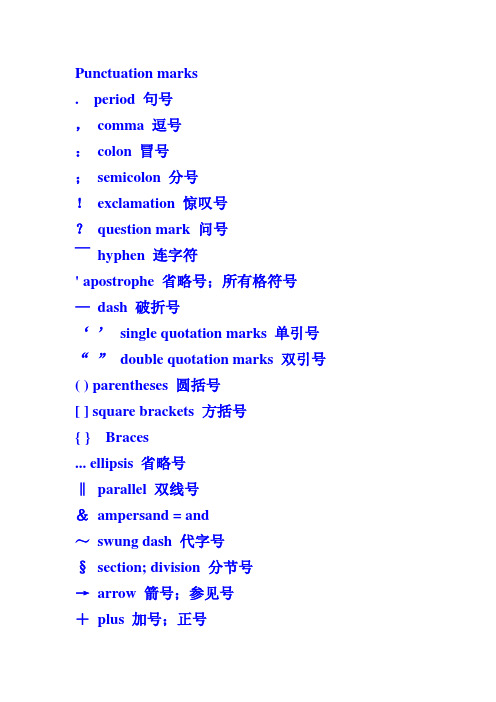
Punctuation marks. period 句号,comma 逗号:colon 冒号;semicolon 分号!exclamation 惊叹号?question mark 问号 ̄hyphen 连字符' apostrophe 省略号;所有格符号—dash 破折号‘’single quotation marks 单引号“”double quotation marks 双引号( ) parentheses 圆括号[ ] square brackets 方括号{ } Braces... ellipsis 省略号‖parallel 双线号&ampersand = and~swung dash 代字号§section; division 分节号→arrow 箭号;参见号+plus 加号;正号-minus 减号;负号±plus or minus 正负号³is multiplied by 乘号÷is divided by 除号=is equal to 等于号≠is not equal to 不等于号≈is approximately equal to 约等于号<is less than 小于号>is more than 大于号≦is not less than 不小于号≧is not more than 不大于号≤is less than or equal to 小于或等于号≥is more than or equal to 大于或等于号%per cent 百分之…‟per mill 千分之…∵since; because 因为∴hence 所以°degree 度#number …号℃Celsius system 摄氏度"/" slash"\" back slash,"_" 下划线underline(英式) underscore (美式)†minute 分或foot 英呎‡second 秒或inch 英吋如40' FCL 40呎滿载集裝箱,1" water pipe 1吋水管²`Glossary of English Grammar Terms/grammar/grammar-gl ossary.htmActive VoiceIn the active voice, the subject of the verb does the action (eg They killed the President). See also Passive Voice.AdjectiveA word like big, red, easy, French etc. An adjective describes a noun or pronoun.AdverbA word like slowly, quietly, well, often etc. An adverb modifies a verb.ArticleThe "indefinite" articles are a and an. The "definite article" is the.Auxiliary VerbA verb that is used with a main verb. Be, do and have are auxiliary verbs. Can, may, must etc are modal auxiliary verbs.ClauseA group of words containing a subject and its verb (for example: It was late when he arrived). ConjunctionA word used to connect words, phrases and clauses (for example: and, but, if).InfinitiveThe basic form of a verb as in to work or work.InterjectionAn exclamation inserted into an utterance without grammatical connection (for example: oh!, ah!, ouch!, well!).Modal VerbAn auxiliary verb like can, may, must etc that modifies the main verb and expresses possibility, probability etc. It is also called "modal auxiliary verb".NounA word like table, dog, teacher, America etc. A noun is the name of an object, concept, person or place. A "concrete noun" is something you can see or touch like a person or car. An "abstract noun" is something that you cannot see or touch like a decision or happiness. A "countable noun" is something that you can count (for example: bottle, song, dollar). An "uncountable noun" is something that you cannot count (for example: water, music, money).ObjectIn the active voice, a noun or its equivalent that receives the action of the verb. In the passive voice, a noun or its equivalent that does the action of the verb.ParticipleThe -ing and -ed forms of verbs. The -ing form is called the "present participle". The -ed form is called the "past participle" (for irregular verbs, this is column 3).Part Of SpeechOne of the eight classes of word in English -noun, verb, adjective, adverb, pronoun, preposition, conjunction and interjection.Passive VoiceIn the passive voice, the subject receives the action of the verb (eg The President was killed). See also Active Voice.PhraseA group of words not containing a subject and its verb (eg on the table, the girl in a red dress). PredicateEach sentence contains (or implies) two parts: a subject and a predicate. The predicate is what is said about the subject.PrepositionA word like at, to, in, over etc. Prepositions usually come before a noun and give information about things like time, place and direction.PronounA word like I, me, you, he, him, it etc. A pronoun replaces a noun.SentenceA group of words that express a thought. A sentence conveys a statement, question, exclamation or command. A sentence contains or implies a subject and a predicate. In simple terms, a sentence must contain a verb and (usually) a subject. A sentence starts with a capital letter and ends with a full stop (.), question mark (?) or exclamation mark(!).SubjectEvery sentence contains (or implies) two parts: a subject and a predicate. The subject is the main noun (or equivalent) in a sentence about which something is said.TenseThe form of a verb that shows us when the action or state happens (past, present or future). Note that the name of a tense is not always a guide to when the action happens. The "present continuous tense", for example, can be used to talk about the present or the future.VerbA word like (to) work, (to) love, (to) begin. A verb describes an action or state.English The Easy Way/Grammar, Learning Egnlish, British Council /grammar_home_f rame.htmlEnglish Grammar/bally/durrus/153/g ramtoc.htmlEnglish Grammar Help - Rules, Worksheets, Games, Quizzes, Exercises/od/englishgrammar/Englis h_Grammar_Help_Rules_Worksheets_Games_Quizzes _Exercises.htmBusiness English Grammar Lessons/exerciselist.ht mlEnglish grammar in context/course/view.php?i d=2708English Grammar Online/Grammar Games, British Council/grammar/archive/grammar_games_index_page01.html Guide to Grammar and Writing。
写作业字迹乱英语

Writing assignments in English can sometimes be challenging,especially when it comes to maintaining neat handwriting.Here are some tips to help you write legibly and effectively:1.Choose the Right Tools:Use a pen or pencil that is comfortable to hold and write with.A pen with a fine tip can help in achieving cleaner lines.2.Proper Posture:Sit up straight with your feet flat on the floor.This helps in maintaining control over your writing.3.Grip Correctly:Hold your pen or pencil with a relaxed grip.Too tight can lead to fatigue and messy handwriting.4.Write Slowly:Speed can often lead to illegibility.Take your time to form each letter properly.5.Practice Regularly:The more you write,the better your handwriting will become. Practice makes perfect.e Guidelines:If youre writing by hand,use lined paper to help keep your writing straight and even.7.Letter Formation:Pay attention to how you form each letter.Consistency in letter size and shape is key to neat handwriting.8.Spacing:Ensure there is adequate space between words and lines.This makes the text easier to read.9.Avoid Erasures:Try to write without making mistakes that require erasing,as this can make the page look messy.e Clear Margins:Leave a clear margin on the left side of the page for easier reading and reference.11.Capitalization:Use capital letters at the beginning of sentences and for proper nouns to improve readability.12.Punctuation:Use punctuation marks correctly to structure your sentences and convey meaning clearly.13.Spelling:Doublecheck your spelling to avoid errors that can distract from the neatness of your writing.14.Consistent Style:Stick to a consistent style of handwriting throughout your assignment to maintain uniformity.15.Review Your Work:Before submitting your assignment,review it to ensure there are no smudges,crossings out,or other distractions.By following these guidelines,you can improve the legibility of your handwritten English assignments,making them easier to read and more likely to make a positive impression on your teachers or peers.。
Punctuation
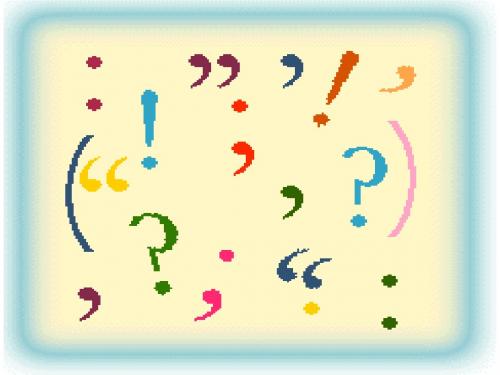
— ;
7. She got there very late felt very sorry.
she
8. I have been here many times
.
9.Many students are studying in the reading room now.
-
10. The next morning came word the thief has been caught. 11. This is David s computer.
girl.
用于书名、剧名等。 用于书名、剧名等。 Have you read the book
“Pride and Prejudice” ?
I have seen the film “Home Alone” twice.
Apostrophe 省字号 撇号 省字号/
[ə'pɔstrəfi] ɔ
To show that letters or figures have been omitted in contractions 用于表示字母或数字被省略的缩略 词中。 词中。
Mild, dry, and clear –– these are the characteristics of weather in Kunming. Try some of the juice –– perhaps you will like it.
What punctuation mark shall we put here ?
Homework
writing
Lose Weight, Necessary or not?
To separate items in a list 用来分开一连串事物。 用来分开一连串事物。 Black, blue, white and green are his favorite colors. I will go to Shanghai, Beijing, and Shenzhen.
English_Punctuation(英文标点符号之使用)
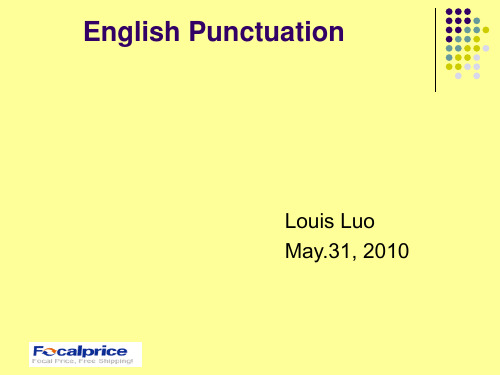
The ground was covered with crocuses, yellow, white and violet.
草地上开满了藏红花,有黄色,白色还有紫色的。 (3) 用在同位语之前 Now, here comes the Secretary-General of Communist Party of China, Chairman, and president of the Central Military Committee, Hu Jintao. 现在出场的是中共中央总书记,国家主席,中央军委主席,胡锦涛。 (4)用在分词短语或者状语之后 用在分词短语或者状语之后 Having been denied by ten persons, the sales man need to recollect his courage. 已经被十个人拒绝了,这个销售人员需要重拾信心。 In the late afternoon, the “Niggers” come to pick up the greens on the ground. 黄昏的时候,黑人开始到街上去捡菜叶。 (5) 用在有关联词连接的两个句子之间 The hero is dead, but his name lives. 英雄虽亡,英明尤存。 英雄虽亡,英明尤存。 Finally the farmer workers get their salary, though it was deemed impossible. 最后,农民工拿到了工资, 最后,农民工拿到了工资,虽然这曾经被视为不大可能
Question Mark-问号 问号
5. Question Mark 问号 (?) 用于提问,用于疑问句之后 Who is the greatest dramatist in English history? 谁是英国历史上最伟大的剧作家? How can you put up with his prejudice for so many years? 你怎么能忍受他的偏见这么多年?
作文三二一开始标点符号

作文三二一开始标点符号英文回答:To start with, punctuation marks play a crucial role in written communication. They help to clarify the meaning of sentences and make the text more coherent and understandable. For example, the use of a period at the end of a sentence indicates a complete thought or idea. Similarly, a question mark is used to indicate a question, while an exclamation mark expresses strong emotions or emphasis. Commas are used to separate items in a list or to indicate a pause in a sentence. Without these punctuation marks, the meaning of the text can be easily misinterpreted.Furthermore, punctuation marks also help to convey the tone and mood of the text. For instance, the use ofellipsis (...) indicates a trailing off or an unfinished thought, while a dash (-) suggests a sudden interruption or change in thought. Quotation marks are used to indicate direct speech or to highlight certain words or phrases.These punctuation marks add depth and nuance to the text, making it more engaging and expressive.In addition, proper punctuation is essential for maintaining clarity and avoiding ambiguity in writing. For example, consider the sentence "Let's eat, Grandma!" Without the comma, the meaning of the sentence would be completely different and could be misinterpreted as an invitation to eat Grandma. The correct use of punctuation marks ensures that the intended meaning of the text is conveyed accurately.Overall, punctuation marks are indispensable in written communication. They help to clarify meaning, convey tone and mood, and maintain clarity and coherence in writing. Without proper punctuation, the text can be confusing and difficult to understand. Therefore, it is important to use punctuation marks correctly and effectively in order to enhance the overall quality of our writing.中文回答:首先,标点符号在书面交流中起着至关重要的作用。
英语作文引用别人的话标点符号
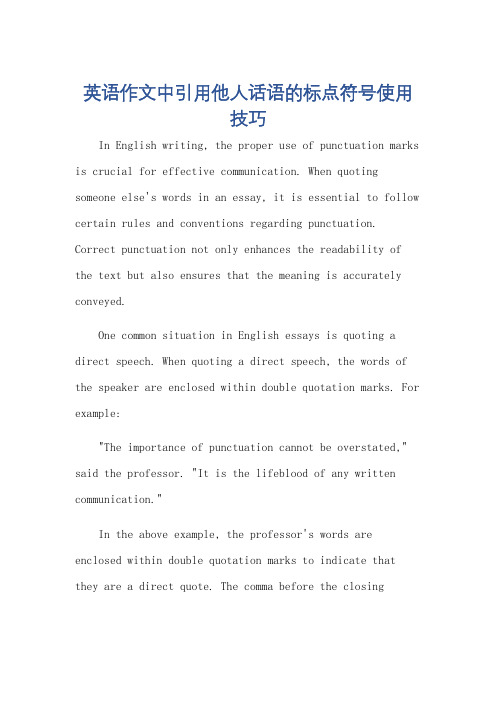
英语作文中引用他人话语的标点符号使用技巧In English writing, the proper use of punctuation marks is crucial for effective communication. When quoting someone else's words in an essay, it is essential to follow certain rules and conventions regarding punctuation. Correct punctuation not only enhances the readability of the text but also ensures that the meaning is accurately conveyed.One common situation in English essays is quoting a direct speech. When quoting a direct speech, the words of the speaker are enclosed within double quotation marks. For example:"The importance of punctuation cannot be overstated," said the professor. "It is the lifeblood of any written communication."In the above example, the professor's words are enclosed within double quotation marks to indicate that they are a direct quote. The comma before the closingquotation mark is used to separate the quote from the rest of the sentence.However, there are cases where the quoted words are not enclosed within double quotation marks. This usually happens when the quoted words are part of the叙述者's own sentence or when the quoted words are not specifically identified as belonging to a particular speaker. For example:Punctuation is essential for clarity and coherence in writing, as it helps to separate ideas and sentences effectively. It is the difference between a well-structured and a chaotic text.In the above example, the quoted words "Punctuation is essential for clarity and coherence in writing" are not enclosed within double quotation marks because they are part of the叙述者's own sentence.Another important point to note is the use of commas and parentheses when introducing quoted words. Commas are usually used when the quoted words are not essential to the meaning of the sentence, while parentheses are used whenthe quoted words provide additional information that is not crucial to the main idea. For example:The author stated, "Punctuation is the soul of writing," emphasizing its importance in communication.In the above example, the quoted words "Punctuation is the soul of writing" are introduced by a comma because they are not essential to the meaning of the sentence. The comma allows the reader to understand that the quoted words are additional information that supports the main idea.On the other hand, if the quoted words provideadditional information that is not crucial to the main idea, parentheses are used. For example:Writing well requires not only good ideas but also effective punctuation (such as commas, periods, and semicolons) to convey those ideas clearly.In the above example, the quoted words "such as commas, periods, and semicolons" are enclosed within parentheses because they provide additional information about the types of punctuation used in writing. These words are not crucialto the main idea of the sentence but rather serve as examples to support the point.In conclusion, the correct use of punctuation marks when quoting others' words in an English essay is crucialfor effective communication. Double quotation marks, commas, and parentheses are some of the most commonly used punctuation marks in this context. Understanding their functions and rules will help writers convey their ideas more accurately and make their essays more readable and engaging.**英语作文中引用他人话语的标点符号使用技巧**在英语写作中,正确使用标点符号对于有效沟通至关重要。
英文标点符号练习(含答案)Punctuation Marks

Punctuation MarksWrite different sentences using the punctuation marks below.1._________________________________________________________________ (Full Stop)2._________________________________________________________________ (Question Mark)3._________________________________________________________________ (Comma)4._________________________________________________________________ (Colon)5._________________________________________________________________ (Semicolon)6._________________________________________________________________ (Apostrophe)7._________________________________________________________________ (Hyphen)8._________________________________________________________________ (En or Em Dash)9._________________________________________________________________ (Exclamation Mark)10.________________________________________________________________ (Quotation Mark)11.________________________________________________________________ (Parentheses)12.________________________________________________________________ (Ellipsis)13.________________________________________________________________ (Slash)Are the punctuation marks in these sentences right or wrong? Correct ones that are wrong.1.Although Raymond will eat a grasshopper, he refuses all green vegetables; such as peas, spinach, and even cucumbers. (vegetables, such)2.Before his calculus exam Scott rubbed his lucky rabbit’s foot and found his favorite pencil. (exam, Scott)3.Francine has five chair’s but six guests coming for Thanksgiving dinner; she hopes that old Uncle Ross remembers to bring an extra. (chairs)4.Rose washed the piles of dirty dishes, while Maria vacuumed the filthy rug; they tried to complete a month’s worth of housekeeping in a single hour. (dishes while)5.Audrey can’t leave work early, and Peggy wont help with the cupcakes, so I guess I’ll have to do all the baking myself. (won’t)6.During our picnic, we were tormented by insects: ants swarming into the potato salad, bees buzzing by our ears, and a katydid jumping into Henry’s open mouth. (OK)7.Roger spent three hour’s writing Christina’s paper. (hours)8.Before you start painting the walls, you’ll need a drop cloth and a ladder. (OK)。
Punctuation英语写作 标点符号

6. The Exclamation Mark
7. Quotation Marks
13. Apostrophe
1. The Comma (,) 1. 在并列句中,连词(and, but, or, for, so, nor, yet) 的前面用逗号。
5. 有些作家在叙述对话时用破折号代替引号。
6. 破折号有时可用来标明副标题或引文的作者。
11. The Slash (/)
1. 斜线表示两项皆可采用。 2. 在连续地抄写诗句时,可用斜线分开原来的诗行。 3. 句中的分数中分子和分母用斜线分开。
4. 斜线有时表示“每”的意思。
12. Italics and Underlining (abc / abc)
4.如某一从句内带有省略,可用分号把它和别 的从句联系起来;省略处有时用逗号标出。
4. The Colon (:)
1.冒号可引进解释、小结或同位语。
2.冒号用于引语或陈述句之前。 3.冒号在记时间时用来区分小时与分钟;在 记赛事比分时用来区分两队比分;在公事 信函中放在称呼之后;在演讲稿中放在对 主席和听众的称呼之后。
Punctuation
What is Punctuation?
Punctuation marks are symbols that indicate the structure and organization of writing, as well as intonation and pauses to be observed when reading.
2. 缩略词一般加句号。
3. 稍稍分开的三个句号就成了省略号,表示在 引语中省略了一个或更多的词。
英语高中小知识点总结
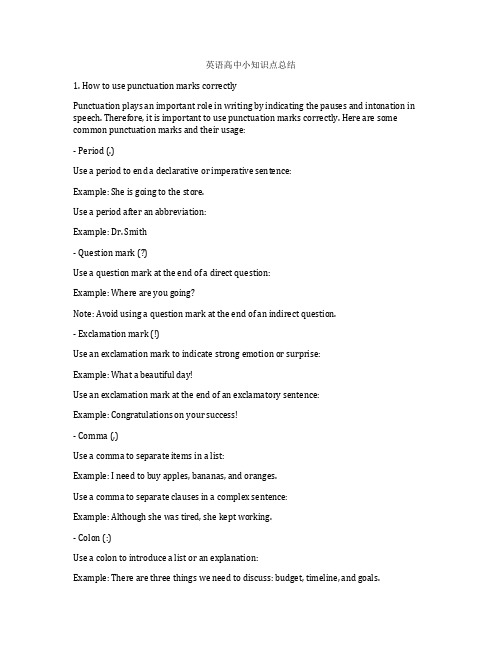
英语高中小知识点总结1. How to use punctuation marks correctlyPunctuation plays an important role in writing by indicating the pauses and intonation in speech. Therefore, it is important to use punctuation marks correctly. Here are some common punctuation marks and their usage:- Period (.)Use a period to end a declarative or imperative sentence:Example: She is going to the store.Use a period after an abbreviation:Example: Dr. Smith- Question mark (?)Use a question mark at the end of a direct question:Example: Where are you going?Note: Avoid using a question mark at the end of an indirect question.- Exclamation mark (!)Use an exclamation mark to indicate strong emotion or surprise:Example: What a beautiful day!Use an exclamation mark at the end of an exclamatory sentence:Example: Congratulations on your success!- Comma (,)Use a comma to separate items in a list:Example: I need to buy apples, bananas, and oranges.Use a comma to separate clauses in a complex sentence:Example: Although she was tired, she kept working.- Colon (:)Use a colon to introduce a list or an explanation:Example: There are three things we need to discuss: budget, timeline, and goals.Use a colon to separate the title and subtitle of a book or article:Example: The Great Gatsby: A Novel by F. Scott Fitzgerald- Semicolon (;)Use a semicolon to join two closely related independent clauses:Example: She loves to read; she has a book with her at all times.Note: The clauses on either side of a semicolon should be able to stand alone as complete sentences.- Quotation marks (" ")Use quotation marks to enclose direct speech or a quotation:Example: "I'll be there in five minutes," he said.Use quotation marks to indicate the titles of short works such as articles, poems, or chapters: Example: "The Road Not Taken"2. Tips for writing a good essayWriting a good essay is an essential skill for high school students. Here are some tips for writing a successful essay:- Understand the promptBefore you start writing, make sure you understand the essay prompt. Identify the key instructions and requirements, and consider the purpose and audience of your essay.- Plan your essayOutline the structure of your essay, including the introduction, body paragraphs, and conclusion. Consider the main points you want to make and the evidence or examples you will use to support your arguments.- Start with a strong introductionBegin your essay with an attention-grabbing opening sentence or a thought-provoking question. Provide some background information and clearly state your thesis statement, which is the main idea of your essay.- Organize your body paragraphsEach body paragraph should focus on a single main point that supports your thesis. Start with a topic sentence that introduces the main idea, followed by supporting details and examples. Use transitions to connect the paragraphs and create a cohesive flow.- Use evidence and examplesSupport your arguments with relevant evidence, examples, or quotations from reliable sources. This will add credibility to your essay and demonstrate your understanding of the topic.- Address counterargumentsAcknowledge opposing viewpoints or counterarguments, and provide a rebuttal to strengthen your position. This shows that you have considered different perspectives and have thought critically about the topic.- Conclude effectivelySummarize the main points of your essay in the conclusion and restate your thesis. Avoid introducing new information in the conclusion, and leave the reader with a lasting impression or a thought-provoking idea.- Revise and editAfter you have completed the first draft of your essay, take the time to revise and edit it. Check for grammar, punctuation, and spelling errors, and ensure that your writing is clear and cohesive.3. How to improve reading comprehensionReading comprehension is the ability to understand and interpret the meaning of a text. Here are some strategies to improve your reading comprehension:- Preview the textBefore you start reading, take a few minutes to preview the text. Look at the title, headings, subheadings, and any visual aids such as images, charts, or graphs. This will give you an overview of the main topics and ideas in the text.- Establish a purpose for readingIdentify why you are reading the text and what information you hope to gain from it. This will help you stay focused and engaged while reading.- Active readingEngage with the text actively by asking questions, making predictions, and connecting the information to your prior knowledge. Highlight or underline important points and take notes as you read.- Monitor your understandingPeriodically stop and check your understanding of the text. If you come across a confusing or unfamiliar word, try to infer its meaning from the context or use a dictionary to look it up. - Summarize the main ideasOnce you have finished reading a section of the text, take a moment to summarize the main ideas in your own words. This will help reinforce your understanding and retention of the material.- Make connectionsRelate the information in the text to your own experiences, other texts you have read, or current events. This will help you better understand and remember the content.- Reread if necessaryIf you encounter difficulties understanding a passage, reread it to clarify your understanding. You can also read aloud or discuss the text with a classmate to gain different perspectives.- Practice regularlyReading comprehension is a skill that improves with practice. Read a variety of texts, including literature, nonfiction, and informational articles, to develop your comprehension abilities.4. How to improve vocabularyHaving a strong vocabulary is essential for effective communication and academic success. Here are some strategies to improve your vocabulary:- Read extensivelyReading books, newspapers, magazines, and online articles exposes you to a wide range of vocabulary. When you come across unfamiliar words, try to infer their meanings from the context or look them up in a dictionary.- Keep a vocabulary journalCreate a journal to record new words you encounter. Write down the word, its definition, and a sentence that illustrates its use. Review and use these words regularly to solidify your understanding.- Use flashcardsCreate flashcards with a new word on one side and its definition and an example sentence on the other side. Review the flashcards regularly to reinforce your memory of the words.- Play word gamesEngage in word games such as crossword puzzles, word searches, and Scrabble to expand your vocabulary in a fun and interactive way.- Learn word roots and affixesUnderstanding word roots, prefixes, and suffixes can help you decipher the meanings of unfamiliar words and expand your vocabulary. For example, the prefix "anti-" means against, so "antibacterial" means against bacteria.- Use the words you learnIncorporate new words into your speaking and writing to practice using them in context. This will help you remember and internalize the words more effectively.- Seek out synonyms and antonymsWhen you encounter a new word, look up its synonyms (words with similar meanings) and antonyms (words with opposite meanings). This will deepen your understanding of the word and expand your vocabulary.- Study word familiesExplore word families, which consist of related words based on a common root. For example, the word "nation" has related words such as national, nationality, and international.- Take advantage of technologyUse dictionary apps, vocabulary-building websites, and language-learning programs to enhance your vocabulary in an interactive and engaging manner.5. The use of verb tensesVerbs are an essential part of speech and are used to express actions, events, and states of being. Understanding and using verb tenses correctly is crucial for effective communication. Here are the main verb tenses and their usage:- Simple present tenseThe simple present tense is used to express actions that are habitual, factual, or timeless, as well as general truths or states of being:Example: She reads books every day.- Simple past tenseThe simple past tense is used to narrate or describe actions or events that occurred in the past:Example: We visited the museum last week.- Simple future tenseThe simple future tense is used to express actions that will occur in the future: Example: They will go to the beach next weekend.- Present continuous tenseThe present continuous tense is used to describe actions that are happening at the moment of speaking or plans and arrangements for the future:Example: She is studying for her exams.- Past continuous tenseThe past continuous tense is used to indicate actions that were ongoing or in progress at a specific time in the past:Example: I was cooking dinner when the phone rang.- Future continuous tenseThe future continuous tense is used to express actions that will be in progress at a specific time in the future:Example: This time tomorrow, I will be attending a job interview.- Present perfect tenseThe present perfect tense is used to indicate actions that were completed in the past and have a connection to the present:Example: He has visited Paris several times.- Past perfect tenseThe past perfect tense is used to show that an action or event happened before another action or event in the past:Example: They had already left when we arrived.- Future perfect tenseThe future perfect tense is used to express an action that will be completed by a specific time in the future:Example: By the time you arrive, I will have finished my homework.It is important for high school students to understand the usage of these verb tenses and to apply them accurately in their writing and speaking.6. How to avoid common grammar mistakesGrammar is the foundation of language and plays a vital role in effective communication. Here are some common grammar mistakes to avoid in writing and speaking:- Subject-verb agreementEnsure that the subject and verb in a sentence agree in number:Incorrect: The students is studying.Correct: The students are studying.- Misuse of pronounsUse pronouns accurately and avoid ambiguous or incorrect pronoun references: Incorrect: Each student must take their own books.Correct: Each student must take his or her own books.- Run-on sentencesAvoid joining two independent clauses without proper punctuation or a conjunction: Incorrect: I went to the store I bought some fruits.Correct: I went to the store, and I bought some fruits.- Misplaced modifiersPlace descriptive words or phrases next to the words they modify to avoid confusion: Incorrect: He almost drove the car on the road.Correct: He drove the car on the road almost.- Subject-verb agreement with collective nounsUse singular verbs with collective nouns when the group is considered as a whole, and use plural verbs when individuals within the group are acting separately:Incorrect: The team are playing well.Correct: The team is playing well.- Double negativesAvoid using two negative words in the same sentence, as they cancel each other out: Incorrect: I don't want no trouble.Correct: I don't want any trouble.- Lack of parallel structureEnsure that items in a list or series are grammatically parallel in form:Incorrect: She likes hiking, to swim, and reading books.Correct: She likes hiking, swimming, and reading books.- Incorrect use of apostrophesUse apostrophes to indicate possession or contraction, but not to create plural forms: Incorrect: The cat's are playing in the yard.Correct: The cats are playing in the yard.By being mindful of these common grammar mistakes, high school students can enhance the accuracy and clarity of their writing and speaking.7. How to develop effective studying habitsEffective study habits are essential for high school students to succeed academically. Here are some strategies to develop effective studying habits:- Create a study scheduleSet aside dedicated time for studying each day and establish a consistent study routine. Consider your energy levels and preferred study times, and strive to create a balanced schedule that includes breaks and leisure activities.- Find a suitable study environmentChoose a quiet, well-lit, and organized space for studying that is free from distractions. This can be a designated study area at home, a library, or a quiet café.- Set specific goalsDefine clear and achievable study goals for each session, whether it be completing a set of homework problems, reviewing a chapter, or preparing for an upcoming test.- Use effective study techniquesExperiment with different study techniques such as note-taking, active reading, concept mapping, and self-testing to find the methods that work best for you. Consider using mnemonic devices, flashcards, and study apps to aid in memorization.- Take regular breaksSchedule short breaks during your study sessions to rest, stretch, and recharge. This can help prevent mental fatigue and increase overall productivity.- Stay organizedKeep track of due dates, assignments, and exams using a planner or digital calendar. Organize your study materials, notes, and textbooks in a way that is easy to access and use.- Seek help and supportDo not hesitate to ask for help from teachers, classmates, or tutors when needed. Form study groups to discuss challenging concepts and share resources.- Practice good self-careMaintain a healthy and balanced lifestyle by getting enough sleep, eating nutritious food, and engaging in regular physical activity. Taking care of your overall well-being can boost your ability to focus and retain information.- Reflect and adjustRegularly evaluate your study habits and adjust your strategies based on your progress and areas of improvement. Be open to trying new techniques and seeking feedback from others.By developing effective studying habits, high school students can maximize their learning potential and achieve academic success.8. How to deliver effective presentationsEffective presentation skills are valuable for high school students in various academic and extracurricular settings. Here are some tips for delivering an effective presentation:- Know your audienceConsider the interests, expectations, and knowledge level of your audience, and tailor your presentation to address their needs and engage them effectively.- Plan and preparePerform thorough research on your topic and gather relevant information from credible sources. Create an outline or a storyboard to organize your content and visuals in a coherent and logical manner.- Start with a strong openingCapture the attention of your audience with a compelling introduction that outlines the purpose and significance of your presentation. Consider using a startling fact, a thought-provoking question, a personal anecdote, or a relevant quote to set the stage.- Use visuals wiselyIncorporate visuals such as slides, images, infographics, and videos to support your main points and enhance the understanding of your audience. Ensure that your visuals are clear, concise, and relevant to the content of your presentation.- Practice effective verbal and nonverbal communicationSpeak clearly, confidently, and at an appropriate pace. Maintain good posture, eye contact, and facial expressions to convey enthusiasm and credibility. Use gestures and body language to emphasize key points.- Engage your audienceEncourage participation and interaction by asking questions, prompting discussion, or incorporating interactive activities. Consider using humor, personal anecdotes, and storytelling to make your presentation memorable.- Organize your contentStructure your presentation with a clear introduction, body, and conclusion. Use transition words and phrases to guide the flow of your presentation and ensure a seamless connection between different segments.- Address potential questionsAnticipate potential questions from your audience and be prepared to provide thorough and thoughtful answers. Encourage questions at the end of your presentation to ensure that your audience understands and engages with the material.- End with a strong conclusionSummarize the main points of your presentation and reiterate your key message. Provide a call to action or suggest further avenues for exploration or discussion.- Seek feedbackAfter delivering your presentation, seek constructive feedback from peers, teachers, or mentors. Reflect on your strengths and areas for improvement, and use the feedback to enhance your future presentations.By mastering effective presentation skills, high school students can effectively convey their ideas, demonstrate their knowledge, and build their confidence in public speaking.9. Understanding literary devicesLiterary devices are techniques and tools used by writers to convey meaning, create imagery, and enhance the impact of their writing. Here are some common literary devices and their usage:- SimileA simile is a figure of speech that compares two unlike things using the words "like" or "as" to create a vivid and imaginative image:Example: The moon is like a silver pearl in the sky.- MetaphorA metaphor is a figure of speech that directly compares two unlike things by implying that one is the other. Metaphors create powerful and figurative comparisons to convey deeper meaning:Example: Time is a thief stealing moments from our lives.- PersonificationPersonification attributes human characteristics or qualities to inanimate objects, animals, or abstract concepts, resulting in more vivid and engaging descriptions:Example: The sun greeted us with a warm smile.- HyperboleHyperbole is an exaggeration or overstatement used for emphasis or to create a dramatic effect:Example: I'm so hungry I could eat a horse.- AlliterationAlliteration is the repetition of initial consonant sounds in neighboring words or syllables, creating a musical and rhythmic effect:Example: The slippery snake slithered silently.- OnomatopoeiaOnomatopoeia is a word that imitates the natural sound of the object or action it refers to, enhancing sensory imagery and adding aural appeal:Example: The bees buzzed around the garden.- ForeshadowingForeshadowing is a literary device in which a writer provides hints or clues about future events in a story, building suspense and anticipation for the reader:Example: The dark clouds hung low, foretelling the approaching storm.- IronyIrony involves a contrast between what is expected and what actually occurs, often creating a sense of surprise, humor, or emotional depth:Example: The fire station burned down.- SymbolismSymbolism is the use of objects, characters, or elements in a literary work to represent deeper meanings or themes beyond their literal sense:Example: The dove is a symbol of peace and harmony.By understanding and recognizing these and other literary devices, high school students can analyze and appreciate literature more deeply and effectively communicate their own creative writing.In conclusion, mastering these little knowledge points in high school English can greatly benefit students in their academic and personal development. From understanding the rules of punctuation and verb tenses to improving reading comprehension and vocabulary, these skills and strategies are essential for effective communication, critical thinking, and academic success. Additionally, developing effective studying habits, delivering compelling presentations, and recognizing literary devices can help students excel in various aspects of their learning journey. As high school students continue to refine their skills and acquire new knowledge, they can confidently navigate the complexities of the English language and express themselves with clarity, creativity, and confidence.。
Punctuation例子
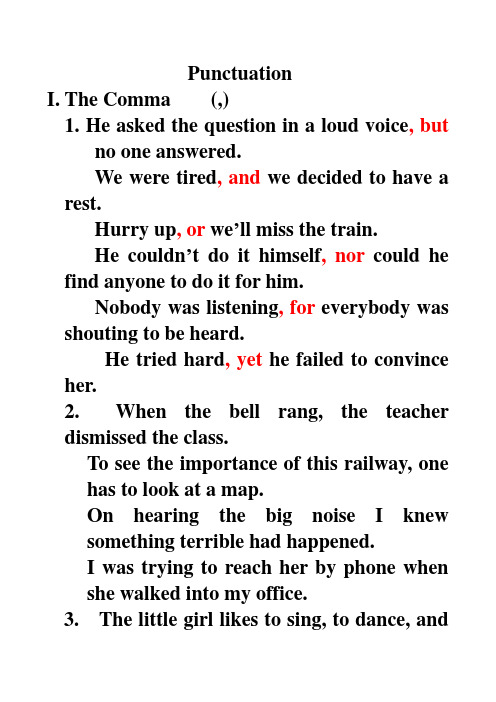
PunctuationI.The Comma (,)1. He asked the question in a loud voice, butno one answered.We were tired, and we decided to have a rest.Hurry up, or we’ll miss the train.He couldn’t do it himself, nor could he find anyone to do it for him.Nobody was listening, for everybody was shouting to be heard.He tried hard, yet he failed to convince her.2. When the bell rang, the teacher dismissed the class.To see the importance of this railway, one has to look at a map.On hearing the big noise I knew something terrible had happened.I was trying to reach her by phone whenshe walked into my office.3. The little girl likes to sing, to dance, andto act.4. Wang Ling, who is the best singer of theclass, will teach us to sing the song.An old lady, nodding and smiling, invited us in.5. The director, in fact, has done very little work.6. Hong Kong was restored to China on July 1, 1997.She was born on 24 May 1979.319,087 23,654,0857. He said, “My trip to Mou nt Tai was interesting but tiring.”II.The Period (.) (。
写作教程第二册chapter 10 punctuation-24页文档资料

10.1 Punctuation
3.How to join sentences of equal weight
10.1 Punctuation
1) warm-up activities:p159 classroom activities 2) Summary of knowledge points:
10.1 Punctuation
Introduction: Punctuation Marks
Full stop /period . Question mark ? Exclamation mark ! Comma , Colon : Semicolon ; Quotation marks “” ‘’
10.1 Punctuation
2. How to end a sentence 1) Reference for the Classroom Activities 1 on p158 Three kinds of punctuation marks can be at the end of
sentences.
composition
Teaching focus
• the functions of punctuation • how to end a sentence, how to join sentences
and how to punctuate a sentence • Writing: a conclusion for a short composition
and organization of written language, ቤተ መጻሕፍቲ ባይዱs well as intonation and pauses to be observed when reading aloud.
英语作文说话标点符号
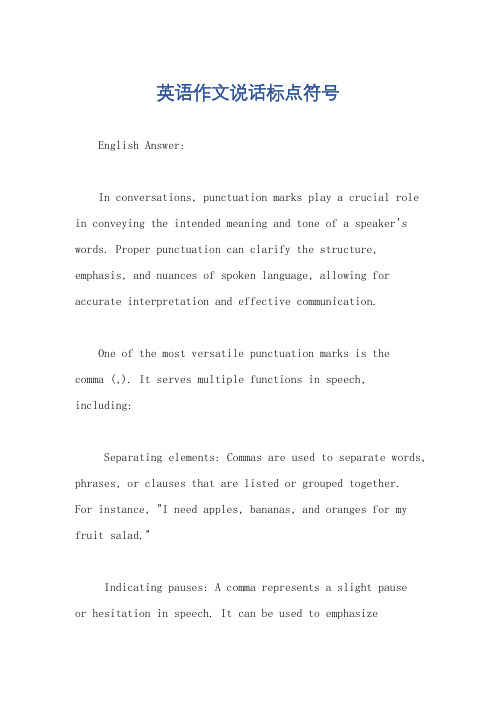
英语作文说话标点符号English Answer:In conversations, punctuation marks play a crucial role in conveying the intended meaning and tone of a speaker's words. Proper punctuation can clarify the structure, emphasis, and nuances of spoken language, allowing for accurate interpretation and effective communication.One of the most versatile punctuation marks is the comma (,). It serves multiple functions in speech, including:Separating elements: Commas are used to separate words, phrases, or clauses that are listed or grouped together.For instance, "I need apples, bananas, and oranges for my fruit salad."Indicating pauses: A comma represents a slight pauseor hesitation in speech. It can be used to emphasizecertain words or phrases or to provide time for thelistener to process information. For example, "I know, it's hard to believe."Introducing subordinate clauses: Commas are often employed to introduce subordinate clauses that provide additional information or explanation. For instance, "She left the house, which was empty and silent."Another essential punctuation mark in speech is the period (.). It serves two primary functions:Ending statements: A period signifies the end of a sentence or complete thought. It indicates that the speaker has finished their idea and is moving on. For example, "I'm going to the store."Indicating abbreviations: Periods are also used to represent abbreviations of words or organizations. For instance, "Mr." for "Mister" or "U.S.A." for "United States of America."The question mark (?) is used to indicate a question or query. It is placed at the end of a sentence that seeks information or clarification. For instance, "What time is it?"Exclamation marks (!) are employed to convey strong emotions or emphasize a particular word or phrase. They can express excitement, surprise, anger, or joy. For instance, "I won the lottery!"In addition to these primary punctuation marks, there are several others that can enhance the clarity and meaning of spoken language:Colons (:) are used to introduce lists, explanations, or quotations.Semi-colons (;) separate closely related independent clauses.Dashes (-) indicate a sudden break in thought or an interruption.Ellipsis marks (...) represent a pause or omission in speech.By understanding and using punctuation marks correctlyin speech, we can effectively communicate our intended messages and avoid misunderstandings. Punctuation helps usto structure our words, convey tone, and clarify meaning, ensuring that our thoughts and ideas are accurately and appropriately expressed.中文回答:在对话中,标点符号在传达说话者话语的意图和语气方面起着至关重要的作用。
Punctuation Marks
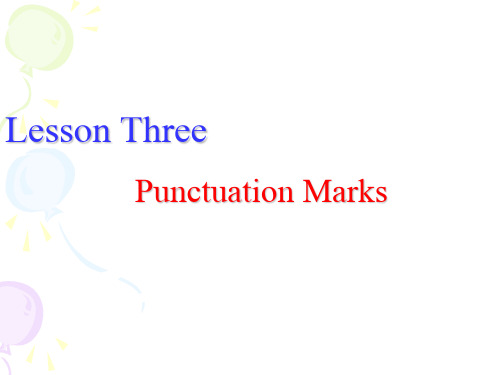
4. The Colon ( : ) P 436 5. The Question Mark ( ? ) P 437 6. The Exclamation Mark ( ! ) P438 7. Quotation Marks (“…”) P439 8. Parenthesis ( ( ) ) P442 9. Brackets ( [ ] ) P443 10. Dash ( ---- ) P444 11. The Slash ( / ) P445 12. Italics and Underling P446
◆! Imperative sentences that express a command or a request and exclamatory sentences expressing a strong feeling or emotion are naturally emphatic. (P 63) Eg. Don’t move! = Freeze! How beautiful! ◆? Rhetorical questions are questions in form but emphatic statements in meaning. (P 63) Eg. I have told you not to touch that new machine. →Haven't I told you not to touch that new machine?
Notes: Conjunctive adverbs like however, therefore, hence, nevertheless, moreover, thus, otherwise, besides, etc., should not be used as conjunctions to link two coordinate clauses. They should be preceded by a semicolon, not a comma.
punctuation
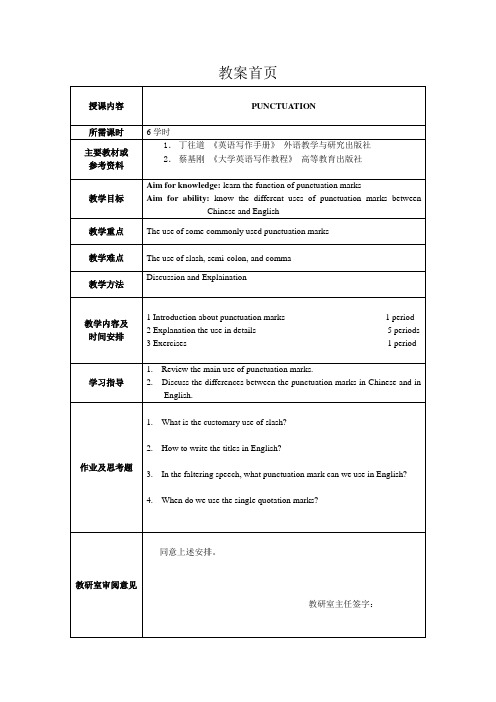
l.to introduce a final summarizing clause
m.in a dialogue
n.to introduce subheadings or authors after quotation
(3)The Slash:
e.in a dialogue
f.to introduce subheadings or authors after quotation
(10)The Slash:
a.to indicate alternatives
b.to separate lines in short quotations ofpoetrybeing quoted in the context
v.to indicate emphasis
III. Punctuation abuse:
Chinese sentences are paratactic (意合的), while the English ones are hypotactic (形合的). Then, the typical mistake like“run-on sentences”(comma splices) often happens
b.after a slogan that expresses a wish
(6)The Quotation marks:
a.to enclose direct speech
b.for titles of articles, essays, short stories, short poems, songs, etc.
c.to enclose words with a special meaning
punctuation 英语标点的使用

e.g. 1) She said, “We have decided to take the examination.” 2) “We have decided to take the examination,” she said. 3) “We have decided,” she said, “to take the examination.”
e.g. 1) When the bell rang, the teacher dismissed the class. 2) In the ancient palace, they saw the throne where emperors used to sit. 3) Born and brought up in the South, she is not used to eating wheat. 4) The audience, interested in the topic, asked the speaker many questions. *You will be unable to finish the work in time if you don’t start at once. *He found the document in one of the drawers of his desk.
The Usage of Colon
Used to make a list Used to make explanations Used to separate the hour from the minute in time references Used to mark the scores of games Used to ternimate the salutation
英文标点符号的使用
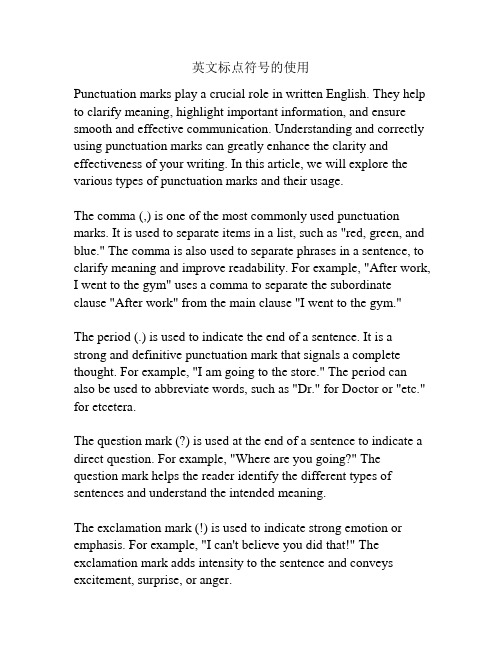
英文标点符号的使用Punctuation marks play a crucial role in written English. They help to clarify meaning, highlight important information, and ensure smooth and effective communication. Understanding and correctly using punctuation marks can greatly enhance the clarity and effectiveness of your writing. In this article, we will explore the various types of punctuation marks and their usage.The comma (,) is one of the most commonly used punctuation marks. It is used to separate items in a list, such as "red, green, and blue." The comma is also used to separate phrases in a sentence, to clarify meaning and improve readability. For example, "After work, I went to the gym" uses a comma to separate the subordinate clause "After work" from the main clause "I went to the gym."The period (.) is used to indicate the end of a sentence. It is a strong and definitive punctuation mark that signals a complete thought. For example, "I am going to the store." The period can also be used to abbreviate words, such as "Dr." for Doctor or "etc." for etcetera.The question mark (?) is used at the end of a sentence to indicate a direct question. For example, "Where are you going?" The question mark helps the reader identify the different types of sentences and understand the intended meaning.The exclamation mark (!) is used to indicate strong emotion or emphasis. For example, "I can't believe you did that!" The exclamation mark adds intensity to the sentence and conveys excitement, surprise, or anger.Quotation marks (" ") are used to indicate direct speech or quoted material. For example, "She said, 'I love you.'" The quotation marks help the reader identify the words spoken by someone else. They should be placed at the beginning and end of the quoted material.The colon (:) is used to introduce a list, explanation, or summary. For example, "There are three colors: red, green, and blue." The colon indicates that a list of items will follow. It can also be used to introduce a quote or a dialogue.The semicolon (;) is used to connect two closely related independent clauses. It is often used to join two sentences that are related in content. For example, "She is studying; he is working." The semicolon adds a sense of continuity between the two ideas.The hyphen (-) is used to join words together. For example, "father-in-law" or "well-known." The hyphen is also used to divide a word at the end of a line to ensure proper spacing and readability.The dash (—) is used to indicate a sudden change of thought or a break in the sentence. For example, "I was walking down the street—suddenly, I saw a ghost!" The dash adds emphasis and draws attention to the unexpected event or idea.The apostrophe (') is used to indicate possession or contraction. For example, "Michael's car" or "can't" (short for "cannot"). The apostrophe helps to clarify the relationship between two words or indicate missing letters.Parentheses ( ) are used to enclose additional information or clarify meaning. For example, "I bought some groceries (apples, bread, and milk) at the store." The parentheses separate and provide extra information that is not crucial to the main sentence.These are just some of the punctuation marks commonly used in English. Each mark has its own purpose and usage rules. Correctly using punctuation marks ensures that your writing is clear, coherent, and easily understood by the reader. So, next time you write, pay attention to the appropriate use of punctuation marks to enhance your writing and communicate your ideas effectively.继续深入探讨关于标点符号的相关内容需要写1500字。
语文作文删除符号
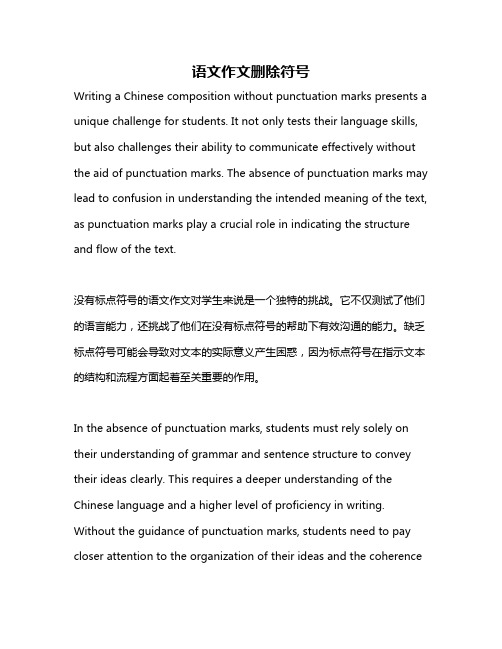
语文作文删除符号Writing a Chinese composition without punctuation marks presents a unique challenge for students. It not only tests their language skills, but also challenges their ability to communicate effectively without the aid of punctuation marks. The absence of punctuation marks may lead to confusion in understanding the intended meaning of the text, as punctuation marks play a crucial role in indicating the structure and flow of the text.没有标点符号的语文作文对学生来说是一个独特的挑战。
它不仅测试了他们的语言能力,还挑战了他们在没有标点符号的帮助下有效沟通的能力。
缺乏标点符号可能会导致对文本的实际意义产生困惑,因为标点符号在指示文本的结构和流程方面起着至关重要的作用。
In the absence of punctuation marks, students must rely solely on their understanding of grammar and sentence structure to convey their ideas clearly. This requires a deeper understanding of the Chinese language and a higher level of proficiency in writing. Without the guidance of punctuation marks, students need to pay closer attention to the organization of their ideas and the coherenceof their arguments to ensure that their message is effectively communicated to the readers.在没有标点符号的情况下,学生必须完全依靠他们对语法和句子结构的理解来清晰地表达他们的想法。
英语作文 破折号
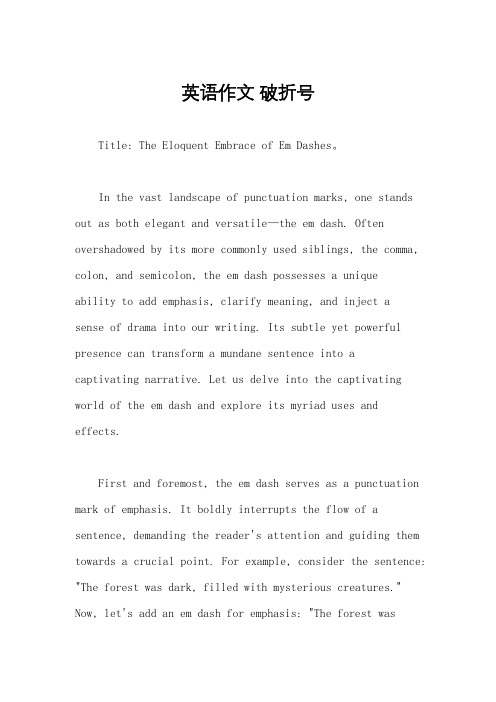
英语作文破折号Title: The Eloquent Embrace of Em Dashes。
In the vast landscape of punctuation marks, one stands out as both elegant and versatile—the em dash. Often overshadowed by its more commonly used siblings, the comma, colon, and semicolon, the em dash possesses a uniqueability to add emphasis, clarify meaning, and inject asense of drama into our writing. Its subtle yet powerful presence can transform a mundane sentence into acaptivating narrative. Let us delve into the captivating world of the em dash and explore its myriad uses and effects.First and foremost, the em dash serves as a punctuation mark of emphasis. It boldly interrupts the flow of a sentence, demanding the reader's attention and guiding them towards a crucial point. For example, consider the sentence: "The forest was dark, filled with mysterious creatures." Now, let's add an em dash for emphasis: "The forest wasdark—filled with mysterious creatures." Notice how the em dash amplifies the sense of mystery and intrigue, drawing the reader deeper into the narrative.Furthermore, the em dash excels in clarifying meaning and enhancing readability. It can be employed to set off additional information within a sentence, providing essential context without disrupting the overall structure. For instance: "The traveler—a weary soul—sought refuge in the quaint inn." Here, the em dashes neatly encapsulate the descriptive phrase, allowing it to seamlessly integrateinto the sentence while maintaining clarity.Moreover, the em dash is a master of punctuation ambiguity, adept at bridging gaps and linking disparate elements. It serves as a versatile connector, facilitating smooth transitions between ideas and enhancing coherence. Take, for example, the sentence: "She was determined to succeed; failure was not an option." Now, let's replace the semicolon with an em dash: "She was determined to succeed—failure was not an option." The em dash forges a stronger connection between the two clauses, reinforcing theprotagonist's unwavering resolve.Additionally, the em dash lends itself to the art of stylistic flair, allowing writers to infuse their prosewith rhythm and cadence. Its judicious use can create a sense of pacing and momentum, guiding the reader throughthe narrative with finesse. Consider the following sentence: "His heart raced—he could hear the distant thunder of hooves." Here, the em dash mirrors the protagonist's escalating heartbeat, heightening the tension and immersing the reader in the moment.In conclusion, the em dash stands as a beacon of punctuation prowess, capable of elevating our writing to new heights. Its innate flexibility and understatedelegance make it a valuable asset in the writer's toolkit, enabling us to craft prose that is both eloquent and engaging. So, let us embrace the em dash wholeheartedly,for it is not merely a punctuation mark but a symbol of our creativity and expression.。
英文作文的书写规则规格
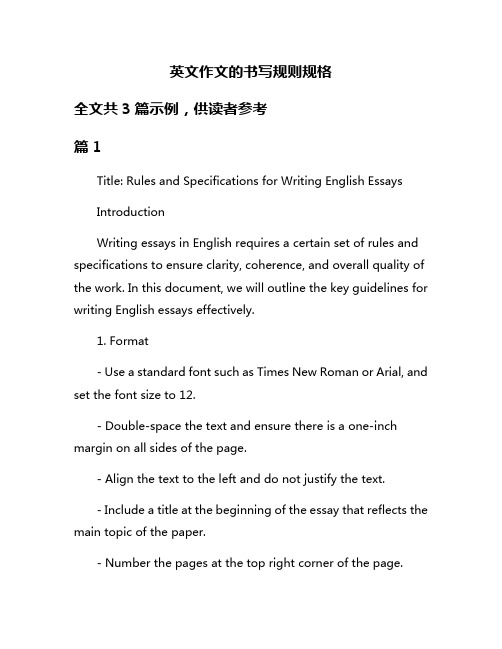
英文作文的书写规则规格全文共3篇示例,供读者参考篇1Title: Rules and Specifications for Writing English EssaysIntroductionWriting essays in English requires a certain set of rules and specifications to ensure clarity, coherence, and overall quality of the work. In this document, we will outline the key guidelines for writing English essays effectively.1. Format- Use a standard font such as Times New Roman or Arial, and set the font size to 12.- Double-space the text and ensure there is a one-inch margin on all sides of the page.- Align the text to the left and do not justify the text.- Include a title at the beginning of the essay that reflects the main topic of the paper.- Number the pages at the top right corner of the page.2. Structure- The essay should have an introduction, body paragraphs, and a conclusion.- The introduction should provide background information on the topic and present a thesis statement.- Each body paragraph should focus on a single idea or argument and include supporting evidence.- Transition smoothly between paragraphs to maintain coherence.- The conclusion should summarize the main points and restate the thesis in a different way.3. Language and Style- Use formal language and avoid contractions (e.g. don’t, can’t).- Choose appropriate vocabulary and avoid using slang or colloquial language.- Write in the third person unless instructed otherwise.- Use academic language and avoid using personal pronouns unless necessary.- Vary sentence structure to maintain reader interest.4. Grammar and Punctuation- Use proper grammar, spelling, and punctuation throughout the essay.- Check for subject-verb agreement, verb tense consistency, and sentence fragments.- Use commas, semicolons, and colons correctly.- Avoid run-on sentences and fragments.- Proofread the essay for errors before submitting.5. Citations and References- When using external sources, cite them properly using a recognized citation style (e.g. APA, MLA).- Include a works cited or references page at the end of the essay.- Paraphrase information from sources and provide in-text citations.- Use quotation marks for direct quotes and provide the page number or website link.ConclusionBy following these rules and specifications for writing English essays, students can improve the quality of their work and convey their ideas more effectively. Practice and attention to detail are key to mastering the art of essay writing in English.篇2Writing an essay in English requires adherence to specific rules and specifications in order to ensure clarity, coherence and standardization. In this document, we will outline the key guidelines for writing an English essay.Format:1. Font: Times New Roman, Arial, Calibri or similar font2. Font Size: 12 point3. Spacing: double-spaced4. Margins: 1-inch margins on all sides5. Alignment: Justified6. Indentation: Paragraphs should be indented7. Headings: Title should be centered and in bold8. Pagination: Page numbers should be included in the header or footerStructure:1. Introduction: Provide a brief overview of the topic and establish the main argument or thesis statement2. Body: Present supporting evidence and arguments in paragraphs, with each paragraph focusing on a single point3. Conclusion: Summarize key points and restate the thesis statement, without introducing new informationLanguage:1. Use formal language and avoid colloquialisms or slang2. Maintain a consistent tone throughout the essay3. Avoid contractions (e.g. can't, won't) and write out full words4. Use transition words and phrases to connect ideas and improve flowGrammar and Punctuation:1. Use correct grammar and spelling2. Use punctuation marks appropriately, including commas, periods, and quotation marks3. Check verb tense agreement and subject-verb agreement4. Avoid run-on sentences and sentence fragmentsCitations:1. Use a consistent citation style (e.g. APA, MLA, Chicago)2. Cite all sources used in the essay, including direct quotes, paraphrased information, and ideas from other sources3. Include a works cited page or bibliography at the end of the essayRevision and Proofreading:1. Review and revise the essay for clarity, coherence, and accuracy2. Check for errors in grammar, punctuation, and spelling3. Have someone else review the essay for feedback and suggestionsBy following these rules and specifications, you can ensure that your English essay is well-structured, coherent, and professional in style. Remember to pay attention to details and make revisions as needed to produce a high-quality essay.篇3The Importance of Proper English Essay Writing Rules and StandardsWriting essays in English is an essential skill for students across the world. Whether you are in school, college, or university, you must follow the established English essay writing rules and standards to communicate effectively and present your ideas clearly. In this document, we will discuss the key rules and standards of writing an English essay to help you enhance your writing skills and excel in your academic endeavors.1. Structure and Organization:The first rule of writing an English essay is to follow a proper structure and organization. Your essay should have an introduction, body paragraphs, and a conclusion. The introduction should introduce the topic and provide a thesis statement. The body paragraphs should present arguments and evidence to support your thesis. The conclusion should summarize your key points and restate your thesis.2. Grammar and Punctuation:Proper grammar and punctuation are essential in English essay writing. Make sure to use correct verb tenses, subject-verb agreement, and punctuation marks. Avoid run-on sentences,fragments, and comma splices. Proofread your essay carefully to correct any grammar and punctuation errors.3. Vocabulary and Style:Choose your words carefully and use a formal tone in your English essay. Avoid slang, colloquialisms, and contractions. Use a variety of vocabulary to express your ideas clearly and concisely. Pay attention to the style of writing and maintain consistency throughout your essay.4. Citation and Referencing:If you use external sources in your English essay, make sure to cite them properly. Follow the citation style recommended by your instructor, such as APA, MLA, or Chicago. Include a bibliography or works cited page at the end of your essay to acknowledge the sources you have used.5. Critical Thinking and Analysis:Engage in critical thinking and analysis in your English essay. Evaluate the evidence and arguments presented in your essay and offer your insights and interpretations. Support your claims with evidence and reasoning to strengthen your argument.6. Revision and Editing:After you have finished writing your English essay, take the time to revise and edit it. Check for errors in grammar, punctuation, spelling, and formatting. Make sure your essay is well-organized and coherent. Ask a peer or instructor to review your essay and provide feedback for improvement.In conclusion, following the established English essay writing rules and standards is essential for effective communication and academic success. By adhering to the proper structure, grammar, vocabulary, citation, critical thinking, and revision, you can enhance your writing skills and produce high-quality essays that impress your readers and instructors. Practice writing regularly and seek feedback to continually improve your English essay writing skills.。
- 1、下载文档前请自行甄别文档内容的完整性,平台不提供额外的编辑、内容补充、找答案等附加服务。
- 2、"仅部分预览"的文档,不可在线预览部分如存在完整性等问题,可反馈申请退款(可完整预览的文档不适用该条件!)。
- 3、如文档侵犯您的权益,请联系客服反馈,我们会尽快为您处理(人工客服工作时间:9:00-18:30)。
• Commas are used to separate a series of words or phrases having the same function in the sentence: • The little girl likes to sing, to dance, and to act. • She buys bread, butter, vegetables, and many other things from this supermarket. • The comma before the conjunction may be omitted if there is no danger of misunderstanding.
• The semicolon is used to separate a series of items which contain internal commas: • On the committee are quite a few wellknown people; for example, Professor Zhao, Dean of the Normal College; Mr. Han, editor-in-chief of the local evening paper; Miss Xu, a popular actress; and Mr. Hu, Director of the bution Marks
Definition & Function
• Punctuation is the system of symbols that we use to separate sentences and parts of sentences, and to make their meaning clear. Each symbol is called a "punctuation mark". • Punctuation helps to clarify and sometimes emphasize the meaning of a sentence. It is necessary to learn to use all the punctuation marks correctly.
• The comma is habitually used in places showing in the following examples: • Yes, I think so. / No, I don‟t think so. • She is the new secretary, isn‟t she? • The delegation will arrive on January 5, 1993. • He said, “The Summer Palace is like a fairyland.” • The factory produced 830,000 bicycles last year.
• Commas set off parenthetical elements (插入语): • Your work, I‟m sorry to say, is not satisfactory. • The director, in fact, has done very little work. • They have many courses: Chinese, English, Mathematics, History, to name just a few.
Types
• • • • • • Comma (,) Period & dot (.) Semicolon (;) Colon (:) Question mark (?) The exclamatory mark (!)
• • • • • •
Quotation mark (“…”) Parentheses ((…)) Brackets ([…]) The dash (—) The slash (/) Italics and underlining
• The comma may be omitted after an adverbial element before the subject if it is short or if the omission does not lead to misunderstanding: • On hearing the big noise I knew something terrible had happened. • In one corner of the room they found the injured cat.
• The semicolon is used with conjunctions when the clauses have internal punctuation: • Unfortunately, Wang couldn't come; and his absence made things difficult for us. • Before he came, we had expected him to help us; but when he was with us, he didn't do much.
The Comma(,)
• The comma ordinarily indicates a pause within a sentence. Suppose you say the following: When he came, I was busy cleaning my room. • You pause after you have said" came", and that is where a comma should be used in the written sentence. But sometimes commas are required by the structure of a sentence, even where no pause in necessary.
The Comma (,)
• A comma is used after an adverbial clause or phrase (including a prepositional phrase or a participle phrase) before the subject of the sentence or in the middle of the sentence. • When the bell rang, the teacher dismissed the class. • The audience, interested in the topic, asked the speaker many questions.
The Value of Punctuation
• An English professor wrote the words, “woman without her man is nothing" on the blackboard and directed the students to punctuate it correctly. The boys wrote: "Woman, without her man, is nothing." The girls wrote: "Woman! Without her, man is nothing."
The Comma(,)
• A comma is used in a compound sentence before the conjunction or connective (and, but, or, for, nor, or yet): He asked the question in a loud voice, but no one answered. We were tired, and we decided to have a rest. Come early, or you'll miss the show. She couldn't go to the airport to meet him, nor could she send anyone in her stead.
• A semi-colon is used to join two coordinate clauses not linked by a conjunction (and, but, or, nor, for, so, yet): • No one is born with knowledge; knowledge must be taught and learned. • He likes popular novels very much; I never read any. • To mark the connection of closely related sentences is the main function of the semicolon.
The Period (.)
• A period (a full stop) is required at the end of a complete sentence. • The period is used with most of the abbreviations: Mr. Mrs. Dr. Ph. D. U.S.A. a.m. In current usage, the period is often dropped from abbreviations, especially for name of organizations, news agencies, and broadcasting companies: UN UNESCO NATO BBC NCX YMCA
